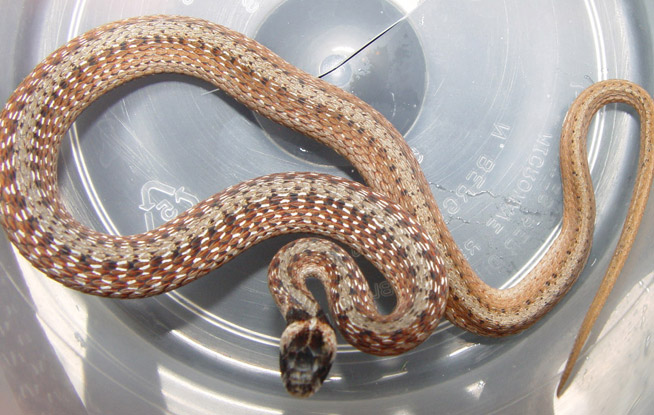
Biology:
The Florida brown snake (Storeria victa) is a species of snake that is native to the southeastern continental United States. The Florida Brown Snake has historically had other scientific names, including Tropidonotus dekayi, Tropidonatus dekayi, Storeria dekayi, Ischnognathus dekayi, Storeria tropica and Storeria dekayi victa. They are known to inhabit Florida, Georgia and perhaps other southern coastal states.
Florida brown snakes are fairly small snakes, usually averaging around 18 centimeters in length, with a range from as little as ten centimeters with exceptionally large specimens up to nearly half a meter in length. The snake is also thin, usually only a few centimeters across. The head is only slightly wider than the rest of the snake, giving the snake a uniform appearance.
These snakes vary in color pattern. They can be brownish, yellow, reddish, gray, or slightly silver in color. Most specimens however fall within the brownish or grayish coloration patterns. The snake does not have much in the way of spots or other patterns, as it tends to have a fairly consistent color. There are however small dark spots running along the belly of the snake.
The belly of these snakes tends to be lighter in color than the top part of the snake. The color of the belly can range from white to yellow to somewhat pinkish.
One distinguishing feature of the Florida brown snake is a banded pattern on the neck. This band on the head is typically a light color, but other variations are known to occur including a dark band or even a reddish band. Near the band there is usually a noticeably darker area. Underneath the head is usually white or cream colored.
Another distinguishing feature of this species of snake is a spot under each eye. This spot also ranges in color but is usually dark. The eyes themselves are large and round, and usually a brown color but can be black.
The Florida brown snake does not produce venom.
Habitat:
The Florida brown snake lives in coastal areas mainly in Georgia and Florida. In Florida they inhabit almost the entire state, including the Florida Keys. They are commonly spotted among loose leaf litter and other plant debris as well as under rocks and dead trees, and can even be seen in people’s yards or gardens from time to time.
This species of snake prefers to live near bodies of water. This means the ecosystems most closely associates with the Florida brown snake are swamps, marshes, ponds, lakes and other transitional regions. Occasionally Florida brown snakes will be seen in open grassy areas or forested regions, but this most likely occurs only when the snake is migrating to a new habitat.
Behaviour:
Florida brown snakes are fossorial, meaning they prefer to burrow rather than slithering about on the surface of the land. They are also nocturnal, meaning they are most active during the nighttime.
They are shy and nonaggressive towards people, preferring to hide from humans rather than confront them. Because they are nonvenomous, a bite from a Florida brown snake is completely harmless other than the slight risk of infection.
Diet:
Most of the Florida brown snake’s diet consists of earthworms and slugs but it is an opportunistic hunter and will eat anything it can get its jaws around. This means that Florida brown snakes will eat small reptiles, frogs, toads, lizards, fish, insects, small birds and even other snakes.
Florida brown snakes are opportunistic hunters and will latch onto any animal that comes its way. This species does not rely on venom or constriction to subdue its prey, but rather on brute jaw strength.
Reproductive:
Florida brown snakes are viviparous, which means that instead of laying eggs the female brown snake will give birth to live young. The snakes breed in the springtime from March through June, which is common among most snake species. The female will usually give birth sometime in the summer months.
This species is unique in the wide range of numbers to which a female can give birth. Sometimes a female will only give birth to a few young, while other times she can give birth to nearly 50 young. It is unclear what determines the size of a particular birthing group but it seems likely that environmental pressures play a key role.
Young Florida brown snakes resemble adults but are smaller. They reach maturity sometime between two and four years.
Many people want to know how to kill a Florida Brown Snake, but you don't need to. The
best way to get rid of Florida Brown Snakes is to simply leave them alone. You can also
use a Florida Brown Snake trap to catch them - that's one of the best ways for how to
remove Florida Brown Snake. For more information, go to my
Snake Removal - How to Get Rid of Snakes home page.
If you need Florida Brown Snake removal in your city, I have friends that I have
personally trained in over 150 cities.